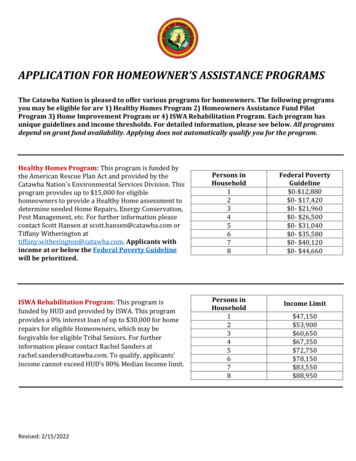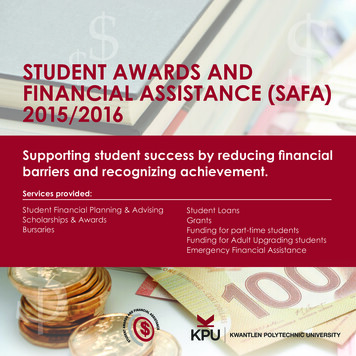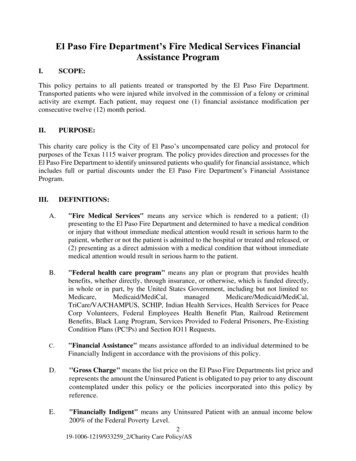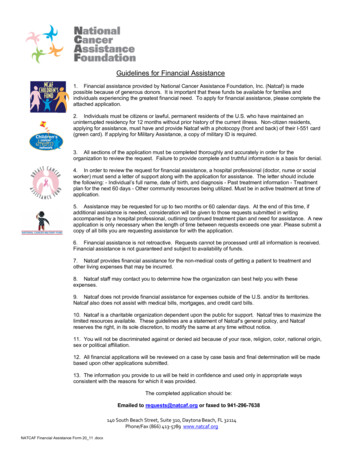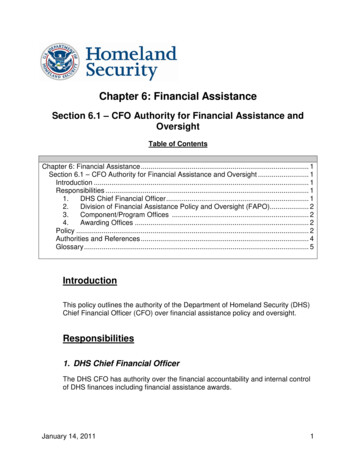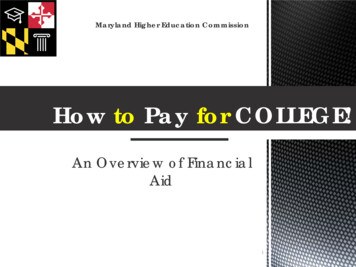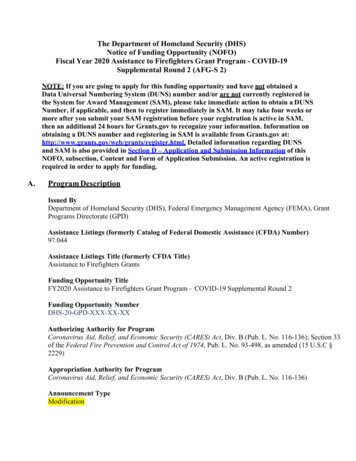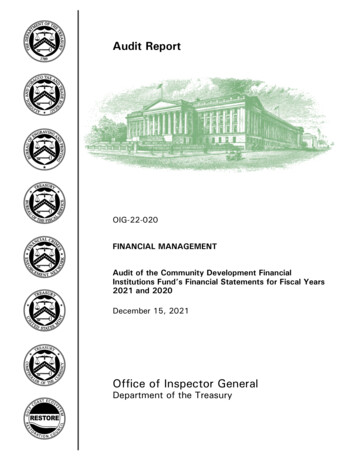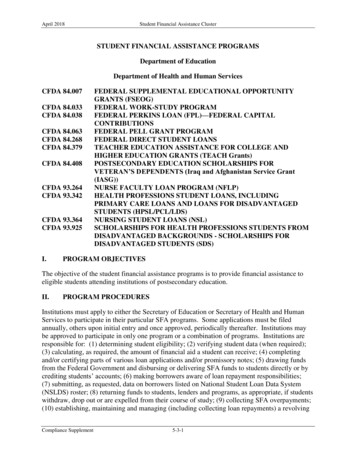
Transcription
April 2018Student Financial Assistance ClusterSTUDENT FINANCIAL ASSISTANCE PROGRAMSDepartment of EducationDepartment of Health and Human ServicesCFDA 84.007CFDA 84.033CFDA 84.038CFDA 84.063CFDA 84.268CFDA 84.379CFDA 84.408CFDA 93.264CFDA 93.342CFDA 93.364CFDA 93.925I.FEDERAL SUPPLEMENTAL EDUCATIONAL OPPORTUNITYGRANTS (FSEOG)FEDERAL WORK-STUDY PROGRAMFEDERAL PERKINS LOAN (FPL)—FEDERAL CAPITALCONTRIBUTIONSFEDERAL PELL GRANT PROGRAMFEDERAL DIRECT STUDENT LOANSTEACHER EDUCATION ASSISTANCE FOR COLLEGE ANDHIGHER EDUCATION GRANTS (TEACH Grants)POSTSECONDARY EDUCATION SCHOLARSHIPS FORVETERAN’S DEPENDENTS (Iraq and Afghanistan Service Grant(IASG))NURSE FACULTY LOAN PROGRAM (NFLP)HEALTH PROFESSIONS STUDENT LOANS, INCLUDINGPRIMARY CARE LOANS AND LOANS FOR DISADVANTAGEDSTUDENTS (HPSL/PCL/LDS)NURSING STUDENT LOANS (NSL)SCHOLARSHIPS FOR HEALTH PROFESSIONS STUDENTS FROMDISADVANTAGED BACKGROUNDS - SCHOLARSHIPS FORDISADVANTAGED STUDENTS (SDS)PROGRAM OBJECTIVESThe objective of the student financial assistance programs is to provide financial assistance toeligible students attending institutions of postsecondary education.II.PROGRAM PROCEDURESInstitutions must apply to either the Secretary of Education or Secretary of Health and HumanServices to participate in their particular SFA programs. Some applications must be filedannually, others upon initial entry and once approved, periodically thereafter. Institutions maybe approved to participate in only one program or a combination of programs. Institutions areresponsible for: (1) determining student eligibility; (2) verifying student data (when required);(3) calculating, as required, the amount of financial aid a student can receive; (4) completingand/or certifying parts of various loan applications and/or promissory notes; (5) drawing fundsfrom the Federal Government and disbursing or delivering SFA funds to students directly or bycrediting students’ accounts; (6) making borrowers aware of loan repayment responsibilities;(7) submitting, as requested, data on borrowers listed on National Student Loan Data System(NSLDS) roster; (8) returning funds to students, lenders and programs, as appropriate, if studentswithdraw, drop out or are expelled from their course of study; (9) collecting SFA overpayments;(10) establishing, maintaining and managing (including collecting loan repayments) a revolvingCompliance Supplement5-3-1
April 2018Student Financial Assistance Clusterloan fund for applicable programs; and (11) reporting the use of funds. Institutions may contractwith third-party servicers to perform many of these functions.Title IV Programs - GeneralThe Title IV programs cited in this cluster that are administered by the Department of Education(ED) (those with CFDAs beginning with 84) are authorized by Title IV of the Higher EducationAct of 1965, as amended (HEA), and collectively are referred to as the “Title IV programs.”Because they are administered at the institutional level, the Federal Perkins Loan Program,Federal Work-Study Program and Federal Supplemental Educational Opportunity Grant Programare referred to collectively as the “campus-based programs.”For Title IV programs, students complete a paper or electronic application (Free Application forFederal Student Aid (FAFSA) (OMB No. 1845-0001) and send it to a central processor (acontractor of ED that administers the Central Processing System). The central processorprovides Student Aid Reports (SARs) to applicants and provides Institutional StudentInformation Records (ISIRs) to institutions. Among other things, the SAR contains theapplicant’s Expected Family Contribution (EFC). Students take their SARs to the institution (orthe institution uses the ISIR) to help determine student eligibility, award amounts, anddisbursements. (Note: The central processor is a service organization of ED, not of the schools.Therefore, AU-C Section 402, Audit Considerations Relating to an Entity Using a ServiceOrganization, does not apply when auditing the schools.)Federal Pell Grant (Pell) (CFDA 84.063)The Federal Pell Grant program provides grants to students enrolled in eligible undergraduateprograms and certain eligible post-baccalaureate teacher certificate programs, and is intended toprovide a foundation of financial aid. The program is administered by ED and postsecondaryeducational institutions. Maximum and minimum Pell grant awards are established by statute.ED provides funds to the institution based on actual and estimated Pell expenditures.Postsecondary Education Scholarships for Veteran’s Dependents(Iraq and Afghanistan Service Grant (IASG)) (CFDA 84.408)The Higher Educational Technical Corrections, Pub. L. No. 111-39, amended the HEA to allowan eligible student whose parent or guardian died as a result of U.S. military service in Iraq orAfghanistan after September 11, 2001, to receive this non-needs-based grant if he or she was notreceiving a Pell grant.Federal Perkins Loan (FPL) (CFDA 84.038)Health Professions Student Loans (HPSL)/Primary Care Loans (PCL)/Loans forDisadvantaged Students (LDS) (CFDA 93.342)Nursing Student Loans (NSL) (CFDA 93.364)The FPL, HPSL/PCL/LDS and NSL programs provide long-term low-interest loans to studentswho demonstrate the need for financial aid to pursue their course of study at postsecondaryeducational institutions. Revolving loan funds are established and maintained at institutionsthrough applications to participate in the programs. The funds are started with the FederalCompliance Supplement5-3-2
April 2018Student Financial Assistance ClusterCapital Contribution (FCC) and a matching Institutional Capital Contribution (ICC).Repayments of principal and interest, new FCC, and new ICC are deposited in the revolvingfunds. The institution is fully responsible for administering the program (i.e., approving,disbursing and collecting the loans). A borrower may have all or part of his or her Perkins loancancelled for qualifying employment as a teacher, as a law enforcement or corrections officer, orin certain other public service occupations. A Perkins borrower also may receive loancancellation for eligible active duty military service and certain volunteer service. In addition,Perkins loans may be discharged if the borrower becomes disabled, dies, or declares bankruptcy,or the school which he or she attended closes. Primary Care Loans are a segment ofHPSL/PCL/LDS loan funds that impose certain restrictions on new borrowers as of July 1, 1993.First-time recipients of these funds after July 1, 1993 must agree to enter and complete aresidency training program in primary health care, not later than 4 years after the date on whichthe student graduates from medical school, and, for new loans issued after March 23, 2010, mustpractice in such care for 10 years (including residency training in primary health care) or throughthe date on which the loan is paid in full, whichever occurs first. Students who received theirfirst HPSL/PCL/LDS before July 1, 1993 are exempt from this requirement, and may continue toborrow HPSL/PCL/LDS loans under their applicable health-related course of study.Nurse Faculty Loan Program (NFLP) (CFDA 93.264)The purpose of the Nurse Faculty Loan Program (NFLP), as authorized by Title VIII of thePublic Health Service Act (PHS Act), Section 846A, as amended by the Patient Protection andAffordable Care Act of 2010, Pub. L. No. 111-148, Section 5311, is to increase the number ofqualified nursing faculty. The NFLP provides funding to schools of nursing to support theestablishment and operation of a distinct NFLP loan fund at the institution. The award to theschool, the FCC award, must be deposited into the NFLP loan fund. The school is required todeposit the ICC that is equal to no less than one-ninth of the FCC award. Participating schoolsmake loans from the regular NFLP loan fund to eligible graduate (master’s and doctoral) nursingstudents to complete the nursing education program. Accredited collegiate schools of nursingare eligible to apply for funding. Eligible schools must offer an advanced education nursingdegree program(s) that will prepare the graduate student to teach. The institution is fullyresponsible for administering the program (i.e., approving, disbursing, and collecting the loans).All funds awarded for the specified budget or project period should be drawn down from thePayment Management System (PMS) account and deposited in an appropriate loan fund. It isexpected that loan activity will be conducted though the institutional NFLP loan fund rather thandrawdowns from the PMS account.Active NFLP grantees are permitted to maintain their loan fund balances in the revolvinginstitutional NFLP loan fund account without fiscal year restriction. The loan fund balanceshould continue to be disbursed (expended) through the current budget or project period.Program guidance is available at ance Supplement5-3-3
April 2018Student Financial Assistance ClusterFederal Work-Study (FWS) (CFDA 84.033)The FWS program provides part-time employment to eligible undergraduate and graduatestudents who need the earnings to help meet costs of postsecondary education. This programalso authorizes the establishment of the Job Location and Development (JLD) program, thepurpose of which is to expand off-campus part-time or full-time employment opportunities forall students, regardless of their financial need, who are enrolled in eligible institutions and toencourage students to participate in community service activities. FWS recipients may also usetheir funds for the Work-Colleges program, whose purpose is to recognize, encourage, andpromote the use of comprehensive work-learning programs as a valuable educational approachwhen it is an integral part of the institution’s educational program and a part of a financial planthat decreases reliance on grants and loans and to encourage students to participate in communityservice activities (34 CFR section 675.43).Funds are provided to institutions upon submission of an annual application, Fiscal OperationsReport and Application to Participate (FISAP) (OMB No. 1845-0030) (this application covers allcampus-based programs), and in accordance with statutory formulae. Institutions must providematching funds unless they are an eligible Title III or Title V institution, or unless the student isemployed in a position which is authorized for payment with 100 percent of Federal funds(34 CFR section 675.26(d)). The institution determines the award amount, places the student ina job, and pays the student or arranges to have the student paid by an off-campus employer. Theinstitution may use a portion of FWS funds for a JLD program.Federal Supplemental Educational Opportunity Grants (FSEOG) (CFDA 84.007)The FSEOG program provides grants to eligible undergraduate students. Priority is given to Pellrecipients who have the lowest expected family contributions. Federal funds are matched withinstitutional funds (34 CFR section 676.21).Teacher Education Assistance for College and Higher Education Grants (TEACH Grants)(CFDA 84.379)The TEACH Grant program is a non-need-based grant program for students who are enrolled inan eligible program, and who agree to serve as a full-time teacher, in a high-need field, in aschool serving low-income students for at least 4 years within 8 years of completing the programfor which the TEACH Grant was awarded (34 CFR section 686.1). If the grant recipient fails tocomplete the required teaching service, the TEACH Grant is treated as a Federal DirectUnsubsidized Stafford Loan (Federal Direct Unsubsidized Loan) (34 CFR section 686.43).Federal Direct Student Loans (Direct Loan) (CFDA 84.268)(Includes subsidized Stafford, unsubsidized Stafford, and PLUS loans)The Direct Loan program makes interest subsidized or unsubsidized Stafford loans available tostudents, or PLUS loans to graduate or professional students or to parents of dependent students,to pay for the cost of attending postsecondary educational institutions. Direct Loans are made bythe Secretary of Education. The student’s SAR or ISIR, along with other information, is used byCompliance Supplement5-3-4
April 2018Student Financial Assistance Clusterthe institution to originate (for Direct Loan) a student’s loan. The financial aid administrator isalso required to provide and confirm certain information.Under the Direct Loan program, institutions participate in loan origination Option 1, Option 2, orStandard origination. Functions performed by loan origination option vary and are described inthe Direct Loan School Guide. Direct Loan is an electronic program, except that borrowers havethe option of signing paper promissory notes or electronically signing the promissory notecompleted online. Except for electronically signed promissory notes, electronic records arecreated, batched, transmitted (exported) through Common Origination and Disbursement (COD)and acknowledged by (imported from) COD, on a cycle approach. A cycle is not complete untilthe last activity in it is finished, i.e., an action has been accepted by COD and the school’ssystem reflects the acceptance. Direct Loan has four types of cycles: Loan Origination Records(one for each loan), Promissory Notes, Disbursement Records, and Change Records. For a loanto be “booked” the institution must have electronically transmitted to COD, and COD must haveaccepted these records: (1) the loan origination record; (2) the Promissory Note; and (3) the firstdisbursement of loan proceeds. The borrower’s original accepted promissory note is maintainedat COD; the institution is not required to keep a copy.Scholarships for Health Professions Students from Disadvantaged Backgrounds Scholarships for Disadvantaged Students (SDS) (CFDA 93.925)The SDS program provides grants to eligible health professions and nursing schools to awardscholarships to financially needy full-time students from disadvantaged backgrounds who areattending schools of medicine, osteopathic medicine, dentistry, nursing, pharmacy, podiatricmedicine, optometry, veterinary medicine, public health, chiropractic or allied health; schoolsoffering graduate programs in behavioral and mental health practice; or entities providingprograms for the training of physician assistants. For purposes of this program, HHS definesdisadvantaged as a student who (1) comes from an environment that has inhibited the individualfrom obtaining the knowledge, skills, and abilities required to enroll in and graduate from ahealth professions school, or from a program providing education or training in an allied healthprofession; or (2) comes from a family with an annual income below a level based on lowincome thresholds according to family size published by the U.S. Bureau of the Census, adjustedannually for changes in the Consumer Price Index, and adjusted by the Secretary of HHS for usein health professions and nursing programs.Submission of Financial Statement Information to EDAll institutions receiving grants or loans from ED under the specified Title IV programs arerequired to input annual financial statement information to ED using eZ-Audit (OMB No. 18450072). The eZ-Audit is the methodology used for reporting an institution’s financial statementinformation. Registration instructions are available . Once an institution has registered,additional guidance on how to input financial statement information is provided.Compliance Supplement5-3-5
April 2018Student Financial Assistance ClusterSource of Governing RequirementsThe ED programs are authorized by Title IV of the Higher Education Act (HEA) of 1965, asamended (20 USC 1001 et seq.). The regulations are found in 34 CFR parts 600 and 668-690.The HHS programs in this cluster are authorized by the Public Health Service Act (PHS Act).The PHS Act was amended by the Health Professions Education Partnership Act of 1998,Pub. L. No. 105-392 and, for the NFLP, further amended by the Patient Protection andAffordable Care Act of 2010 (Affordable Care Act), Pub. L. No. 111-148, Section 5311.Availability of Other Program InformationED annually publishes the Federal Student Aid Handbook (FSA Handbook), which providesdetailed guidance on administering the Title IV programs. This handbook and other guidancematerial are available at http://ifap.ed.gov/.HHS publishes the Student Financial Aid Guidelines, which provide detailed guidance onadministering the Title VII and VIII programs. This and other materials are available athttp://bhpr.hrsa.gov/.III.COMPLIANCE REQUIREMENTSIn developing the audit procedures to test for compliance with the requirements for theSFA cluster, the auditor must determine, from the following summary (also included inPart 2, “Matrix of Compliance Requirements”), which of the 12 types of compliancerequirements apply, and then determine which of the applicable requirements is likely tohave a direct and material effect on the SFA cluster at the auditee. For each suchrequirement, the auditor must use Part 3 (which includes generic details about eachcompliance requirement other than Special Tests and Provisions) and this clustersupplement (which includes any cluster-specific requirements) to perform the audit.Compliance RequirementsYNCompliance SupplementYYNY5-3-6N(ED)Y(HHS)NYYNNSpecial HPeriod ofPerformanceGMatching,Level rinciplesActivitiesAllowed orUnallowedAY
April 2018Student Financial Assistance ClusterNote: While the programs included in this cluster are generally similar in their intent,administration and documentation, etc., there are differences among them. Because of spaceconsiderations, this cluster supplement does not list all of the differences, exceptions to generalrules or nuances pertaining to specific programs. Auditors should use regulations and guidanceapplicable to the year(s) being audited when auditing the SFA programs.A.Activities Allowed or UnallowedSFA funds can be awarded only to students enrolled in eligible programs. Eligibleprograms are listed on an institution’s Eligibility and Certification Approval Report(ECAR). Other programs can be added after the school’s most recent certificationwithout obtaining ED’s approval if they lead to an associate, baccalaureate, professional,or graduate degree or are at least 8 semester hours, 12 quarter hours, or 600 clock hours,and they prepare students for gainful employment in the same or a related occupation of apreviously ED-designated eligible program (34 CFR section 600.10(c)(2)).SFA funds can be used for making awards to students, for administration of theprograms, and other allowable uses for specific programs as follows:Federal Perkins Loan (CFDA 84.038)Certain billing, collection, and litigation costs must first be charged to the borrower andcannot be charged to the loan fund. If amounts recovered from the borrowers are notsufficient to pay these collection costs, program funds can be used to pay these costs withcertain limits (34 CFR sections 674.8 and 674.47).A school may transfer up to a total of 25 percent of its FCC for an award year to either orboth the FSEOG and FWS programs (34 CFR section 674.18(b)(1)). A school maytransfer up to 100 percent of its initial and supplemental allocations to an approved WorkColleges program (34 CFR section 675.18(b)(2)). Transferred funds must be usedaccording to the requirements of the program to which they are transferred. A school thattransfers funds to the FWS, FSEOG, or Work Colleges programs must transfer anyunexpended funds back to the Federal Perkins Loan program at the end of the award year(34 CFR section 674.18(b)(5)).Federal Work-Study (CFDA 84.033)The institution may use FWS funds only for awards to students, a Job Location andDevelopment (JLD) Program, Work-Colleges Program (as defined in 34 CFR section675.41(a)), administrative costs, and transfers to FSEOG (34 CFR sections 675.18 and675.33).Federal Supplemental Educational Opportunity Grant (CFDA 84.007)An institution may transfer up to 25 percent of its FSEOG financial allotment to theinstitution’s FWS program (Section 488 of HEA (20 USC 1095)).Compliance Supplement5-3-7
April 2018Student Financial Assistance ClusterHealth Professions Student Loans/Primary Care Loans /Loans for DisadvantagedStudents (CFDA 93.342) and Nursing Student Loans (NSL) (CFDA 93.364)Funds from both programs may also be used for capital distribution in Sections 728 and839, or, as agreed to by the Secretary of HHS for costs of litigation; costs associated withmembership in credit bureaus and, to the extent specifically approved by the Secretary,for other collection costs that exceed the usual expenses incurred in the collection of loanfunds (HPSL/PCL/LDS, 42 CFR section 57.205(a); NSL, 42 CFR section 57.305(a)).Nurse Faculty Loan Program (NFLP) (CFDA 93.264)Funds may be used for capital distribution under Section 846A of the PHS Act, TitleVIII, as further amended by the Patient Protection and Affordable Care Act of 2010, Pub.L. No. 111-148, Section 5311or, as agreed to by the Secretary of HHS for costs oflitigation; costs associated with membership in credit bureaus and, to the extentspecifically approved by the Secretary, for other collection costs that exceed the usualexpenses incurred in the collection of NFLP loan funds.C.Cash ManagementED provides funds to an institution under the advance, reimbursement, or cashmonitoring payment methods.The advance payment method is the most widely used payment method. It permits, butdoes not require, institutions to draw down Title IV funds prior to disbursing funds toeligible students and parents. The institution’s request must not exceed the amountimmediately needed to disburse funds to students or parents. A disbursement of fundsoccurs on the date an institution credits a student’s account or pays a student or parentdirectly with either SFA funds or institutional funds. The institution must make thedisbursements as soon as administratively feasible, but no later than 3 business daysfollowing the receipt of funds. Any amounts not disbursed by the end of the thirdbusiness day are considered to be excess cash and generally are required to be promptlyreturned to ED (34 CFR section 668.166(a)(1)). Excess cash includes any funds receivedfrom ED that are deposited or transferred to the institution’s Federal account as a result ofan award adjustment, cancellation, or recovery. However, an excess cash balancetolerance is allowed if that balance (1) is less than one percent of its prior-yeardrawdowns; and (2) is eliminated within the next 7 calendar days (34 CFR sections668.166(a) and (b)). Except for FPL program earnings, aggregate interest earningsgreater than 500 must be remitted to the Department of Health and Human Services(HHS). FPL earnings are reinvested in the FPL fund (34 CFR sections 674.8(a)(6) and668.163(c)).Under the reimbursement payment method, the institution must disburse funds to thestudents before requesting funds from ED. Under the cash monitoring payment method,the institution must disburse funds to students before requesting funds from ED undereither the advance payment method (limited to the actual disbursement amount, known as“Heightened Cash Monitoring 1”) or a process similar to the reimbursement method(known as “Heightened Cash Monitoring 2”). (See Chapter 1, “Requesting & ManagingCompliance Supplement5-3-8
April 2018Student Financial Assistance ClusterFSA Funds” in Volume 4, of the FSA Handbook, for guidance on the funding methods.The handbook may be accessed from links at:https://ifap.ed.gov/ifap/byAwardYear.jsp?type fsahandbook).Institutions request funds from ED by (1) creating a payment request using the G5System through the Internet; or (2) if the grantee is placed on the reimbursement or cashmonitoring 2 payment method, submitting a Form 270, Request for Title IVReimbursement or Heightened Cash Monitoring 2 (HCM2) (OMB No. 1845-0089) to anED program or regional office. When creating a payment request in G5, the granteeenters the drawdown amounts, by award, directly into G5. Direct Loan schools andgrantees can redistribute drawn amounts between grant awards by making adjustments inG5 to reflect actual disbursements for each award as long as the net amount of theadjustments is zero. When requesting funds using the other two methods, institutionsprovide drawdown information to the hotline operator or on the Form 270, as applicable.To assist institutions in reconciling their internal accounting records with the G5 System,using their DUNS (Data Universal Numbering System) number, institutions can obtain aG5 External Award Activity Report (https://www.g5.gov/; under the “Payment” tab)showing cumulative and detail information for each award. The External Award ActivityReport can be created with date parameters (Start and End Dates) and viewed on-line. Toview each draw per award, the G5 user may click on the award number to view a displayof individual draws for that award.For the HHS programs, requests for new FCC must only be made when needed. Anymonies associated with the fund must be deposited in an income-producing account andall excess cash, including interest earned in excess of 500 in the aggregate, must bereturned to HHS.For HPSL/PCL/LDS, and NSL, the school must maintain all monies relating to eachindividual fund in interest bearing accounts. If the school integrates the funds with otherschool resources for investment purpose, the school must maintain separateaccountability and reimburse the funds for any losses that occur (HPSL/PCL/LDS 42CFR sections 57.203 and 57.205; NSL, 42 CFR sections 57.303 and 57.305).For NFLP (CFDA 93.294), the school must maintain all monies relating to eachindividual fund in interest-bearing accounts. Any monies associated with the fund mustbe deposited in an income-producing account and all excess cash, including any interestearned in excess of 500 in the aggregate, must be returned to HHS. Unused loan fundsshould be retained in the loan fund for making additional loans. However, unused NFLPfunds must be used within 18 calendar months from the end of the NFLP designatedbudget period. The unused accumulation (cash balance) in the NFLP fund must bereported annually. The NFLP loan fund may be voluntarily or involuntarily terminated ifthe unused accumulation is deemed excessive. If a school is determined to have anexcessive unused accumulation, future awards may be affected (Program Guidance,Overview of Institutional Management of NFLP Funds).Compliance Supplement5-3-9
April 2018E.Student Financial Assistance ClusterEligibility1.Eligibility for IndividualsMost of the requirements for student eligibility are contained in Appendix A(located after Section IV, “Other Information,” of this Part 5).In the process of a student applying for ED Federal financial aid, an InstitutionalStudent Information Record (ISIR) normally is sent electronically to theinstitution and a Student Aid Report (SAR) may be sent to the student. Theoriginal ISIR or SAR for an award year may contain codes that relate to studenteligibility requirements numbers 2, 4, 5, 9, 10, and 12 in Appendix A. If theoriginal ISIR or SAR does not contain codes relating to those eligibilityrequirements, and the institution has no information indicating otherwise, thestudent can be considered to have met them. The ISIR Guide contains all the ISIRand SAR codes and is available athttp://www.ifap.ed.gov/ifap/byAwardYear.jsp?type isirguide. The ISIR Guidechanges annually and should be obtained and reviewed for the period under audit.Calculation of BenefitsIn addition to the requirements and limits described below, awards must becoordinated among the various programs and with other Federal and non-Federalaid (need and non-need based aid) to ensure that total aid is not awarded in excessof the student’s financial need (34 CFR section 668.42, FPL, FWS, and FSEOG,34 CFR sections 673.5 and 673.6; Direct Loan, 34 CFR section 685.301; HPSL,PCL, and LDS, 42 CFR section 57.206; NSL, 42 CFR section 57.306(b)); NFLP,Affordable Care Act, Section 5311 and Program Guidance). The TEACH Grantis a non-need based grant and may replace a student’s EFC, but the amount of thegrant that exceeds the student’s EFC is considered estimated financial assistance(34 CFR section 686.21(d)). An IASG-eligible student who has an EFC that doesnot meet the needs-based criteria for a Pell grant can receive a non-needs basedIASG and the maximum amount of a Pell award available, but the (1) award maynot exceed the student’s cost of attendance (COA) and (2) IASG is not consideredestimated financial assistance (20 USC 1070h).The determination of SFA award amounts is based on financial need. Financialneed is generally defined as the student’s COA minus financial resourcesreasonably available. In determining the financial resources available for theHHS programs, the school must use one of the need analysis systems or any otherprocedures approved by the Secretary of Education. The school must also takeinto account other information that it has regarding the student’s financial status.For Title IV programs, the financial resources available is generally the ExpectedFamily Contribution (EFC) that is computed by the central processor and includedon the student’s SAR and the ISIR provided to the institution.Compliance Supplement5-3-10
April 2018Student Financial Assistance ClusterAn institution may (1) exclude, from both estimated financial assistance and theCOA, financial assistance provided by a State if that assistance is designated bythe State to offset a specific component of the COA; (2) include the one-time costof a student obtaining his or her first professional license or certificate; and(3
withdraw, drop out or are expelled from their course of study; (9) collecting SFA overpayments; (10) establishing, maintaining and managing (including collecting loan repayments) a revolving . . Therefore, AU-C Section 402, Audit Considerations Relating to an Entity Using a Service Organization, does not apply when auditing the schools.)
